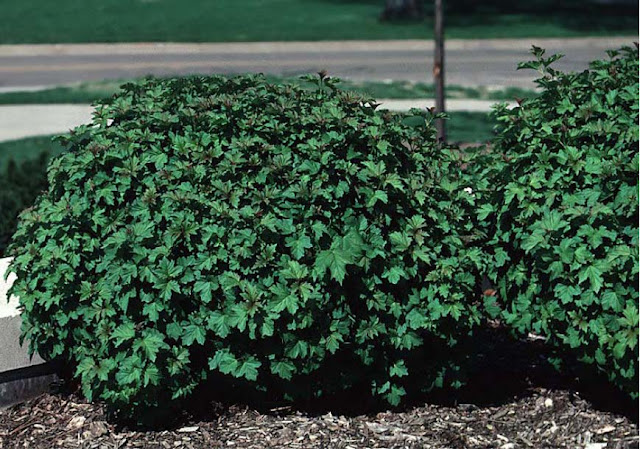Viburnum opulus 'Nanum'
syn. Opulus sterile
European Cranberrybush Viburnum, Crampbark, European Highbush Cranberry,
Guelder Rose
Type Shrub, woody plant
Hardy range 3B to 8A
Height 24" to 4' / 60cm to 1.20m
Spread 36" to 8' / 90cm to 2.40m
Growth rate Average
Form Oval and upright or erect
Exposure Partial shade or partial sun to full sun
Persistence Deciduous
Bloom Color White
Bloom Time Spring
The flowers are very showy.
Environment
This plant tolerates some drought and some salt.
This plant will grow in dry soil.
Suitable soil is well-drained/loamy, sandy or clay.
The pH preference is an acidic to alkaline (less than 6.8 to more than 7.7) soil.
Leaf Color Green
F all Color Purple and red
Culture Notes
Likes acid soil kept moist, but not wet, for best development. The species appears to adapt better to wet soil. Nice large shrub for all seasons. Plant flowers in sun to part shade. European Highbush Cranberry tolerates most light exposures and soil types. The plant tolerates pruning and should be thinned occasionally to renew it. It transplants easily, and has a mature height and spread of 12 feet or more. The white flowers are produced in late spring, and the red fruit is ornamental from late summer to early fall but very distasteful. Some plants may not flower or fruit well.
Planting and establishing shrubs
The most common cause of young plant failure is planting too deep. Plant the root ball no deeper than it was in the nursery. In most instances, the root flare zone (point where the top-most root in the root ball originates from the trunk) should be located just above the landscape soil surface. Sometimes plants come from the nursery with soil over the root flare. If there is soil over this area, scrape it off. The planting hole should be at least twice the width of the root ball, preferably wider. In all but exceptional circumstances where the soil is very poor, there is no need to incorporate anything into the backfill soil except the loosened soil that came out of the planting hole. Never place ANY soil over the root ball. If a row or grouping of plants is to be installed, excavating or loosening the soil in the entire bed and incorporating organic matter enhances root growth and establishment rate.
Weed suppression during establishment is essential. Apply a 3-inch thick layer of mulch around the plant to help control weed growth. Keep it at least 10 inches from the trunk. If you apply it over the root ball, apply only a one or two inch layer. This allows rainwater and air to easily enter the root ball and keeps the trunk dry. Placing mulch against the trunk or applying too thick a layer above the root ball can kill the plant by oxygen starvation, death of bark, stem and root diseases, prevention of hardening off for winter, vole and other rodent damage to the trunk, keeping soil too wet, or repelling water. Regular irrigation through the first growing season after planting encourages rapid root growth, which is essential for quick plant establishment.






No comments:
Post a Comment
Please feel free to comment on any post at any time all feedback is welcome and we’d love to hear it.